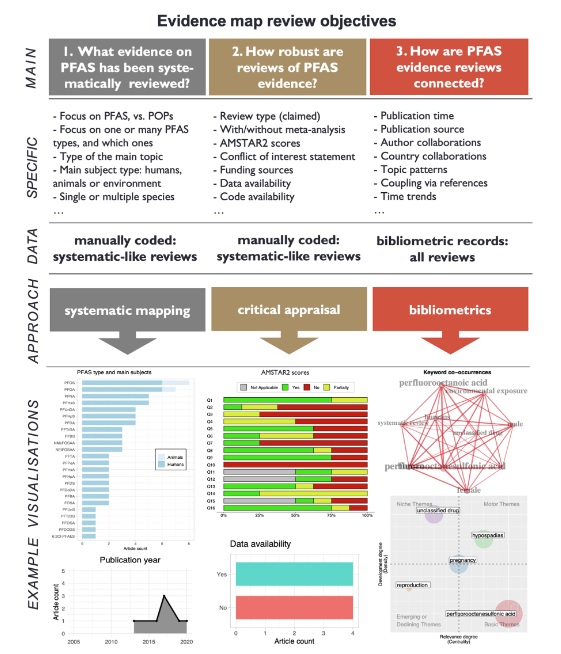Publication
The paper on the protocol for this study was published in Environment International in January 2022.
 Aims
Aims

Figure 1: Three main study objectives, data extraction and analytic approaches. Plots represent examples of visualisations of selected outcomes, based on the preliminary analyses of the pilot data from eight studies. Further details of the analytic approaches and visualisations are provided in supplementary files on GitHub (https://mlagisz.github.io/UmbrellaReview_PFAS_pilot/)
After seven decades of intensive PFAS production and use, PFAS can be found in the environment, wildlife, domestic animals and humans worldwide. People and animals incorporate PFAS mostly with their diet and drinking water. Due to the strong biochemical bond between pollutants and proteins, PFAS can accumulate and remain in the body for several years. PFAS exposure can result in an increased risk contributing to certain unfavourable conditions that include premature birth, breast cancer and obesity in people.
Since the early 2000s, researchers from all over the world have performed a large number of studies exploring a wide range of topics related to PFAS (burdens in humans and animal, health consequences of exposure etc.). To compare these studies and to gain an overview of the created knowledge, multiple review studies have been performed.
This study aims to identify and collect review studies on PFAS in the environment, animals and people. We will collate these studies and create an umbrella review and a systematic map [Link to Data synthesis methods page] to show what types of reviews have been performed and which areas of PFAS research have been reviewed.
This project will provide a comprehensive insight into the secondary literature of PFAS research. It will show the quality of the PFAS reviews, what types of reviews are still missing and which areas have been satisfyingly investigated. Our study will provide an easily approachable overview of the PFAS review literature that will help researchers, the general public and policy makers alike, to grasp the existing state of knowledge and direct future research.
 Methods
Methods
We did not perform any lab experiments ourselves. Instead, we collected the available scientific reviews on PFAS in the environment, animals, and people, and created an umbrella review and a systematic map. Both techniques are well established in the field of data synthesis.
We screened the available literature for review papers that investigated one of the following areas: levels of PFAS contamination, the health impact of PFAS, detection strategies for PFAS and the analysis of toxicity of PFAS in living organisms, their tissues or in the environment. We excluded reviews that looked into studies that investigated removal technologies of PFAS from wastewater, manufacturing technologies of PFAS and PFAS-related policies and management. Following this, we extracted key data (e.g., type of review, PFAS type, study species, quality-related information) and summarised them in figures and tables.
Furthermore, we will perform a bibliometric analysis that provides insight into the ‘infrastructure’ of PFAS review research. That means that the analysis will include the visualization of the different research disciplines involved in the field (e.g., cancer research, environmental pollution) and the network of collaborating researchers, their institutions and countries.
 Findings
Findings
Pending – we are currently finalizing analyses of our data and writing up results.
 Conclusions
Conclusions
Pending.